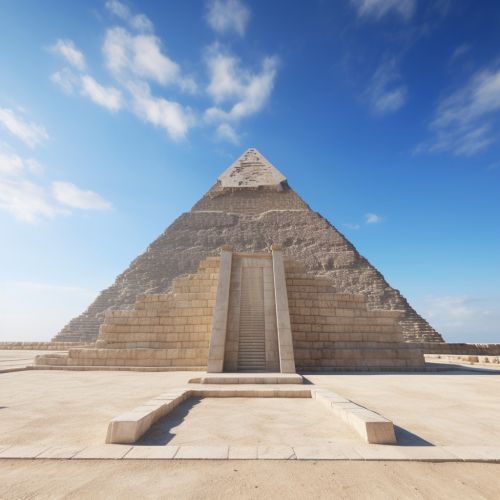Great Pyramid of Giza
History
The Great Pyramid of Giza, also known as the Pyramid of Khufu or the Pyramid of Cheops, is the oldest and largest of the three pyramids in the Giza Plateau in Egypt. It is believed to have been built as a tomb over a 20-year period during the reign of Pharaoh Khufu (Cheops), who ruled during the Fourth Dynasty of the Old Kingdom. The pyramid was constructed approximately between 2580 and 2560 BC, making it over 4,500 years old.


The pyramid was built using an estimated 2.3 million stone blocks, each weighing an average of 2.5 to 15 tons. The pyramid was originally covered by casing stones that formed a smooth outer surface, but most of these have been removed over time, exposing the underlying step-like structure. The pyramid was the tallest man-made structure in the world for over 3,800 years until the completion of Lincoln Cathedral in England in the 14th century.
Construction
The construction methods used in building the Great Pyramid of Giza are still the subject of debate among researchers and historians. The Greeks believed that slave labor was used, but modern discoveries suggest that the pyramid was built by tens of thousands of skilled workers. These workers lived in a temporary city near the pyramid, which provided them with food, drink, and medical care.
The exact method of moving and placing the stone blocks is also a topic of ongoing research. Some theories suggest the use of large sledges and ramps, while others propose the use of levers or cranes. The precision with which the pyramid was built, with such consistent angles and proportions, is a testament to the advanced engineering skills of the ancient Egyptians.
Interior
The interior of the Great Pyramid contains three known chambers. The lowest chamber, cut into the bedrock upon which the pyramid was built, was unfinished. The so-called Queen's Chamber and King's Chamber are higher up within the pyramid structure. The main part of the Giza complex is a series of buildings that included two mortuary temples in honor of Khufu, three smaller pyramids for Khufu's wives, an even smaller "satellite" pyramid, a raised causeway connecting the two temples, and small mastaba tombs for nobles surrounding the pyramid.
The King's Chamber is entirely faced with granite. Above the roof, which is also constructed of granite beams, are five compartments known as "relieving chambers". The purpose of these chambers is to distribute the weight of the massive stones above the King's Chamber and protect it from collapsing.
Significance
The Great Pyramid of Giza is the only one of the Seven Wonders of the Ancient World that remains largely intact. It is a testament to the architectural prowess of the ancient Egyptians and continues to be a major tourist attraction. The pyramid complex, including the Great Sphinx, is a UNESCO World Heritage Site and was voted as one of the New Seven Wonders of the World in a global poll conducted in 2000.
